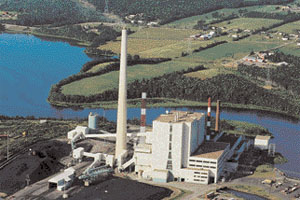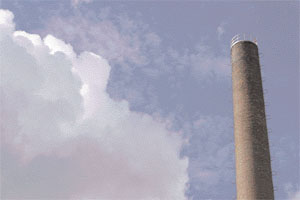Inspecting and Maintaining Industrial Chimneys
By Brian L. Cooley, P.E., S.E.

Within the last few years, the growing cellular phone industry has undertaken the task of adding thousands of new antennas to improve the quality of its service. Since they have the need to locate antennas at regular intervals throughout large urban settings, some of the networks have contracted with owners of existing properties to attach them to the tallest structures in the area. Many of these locations happen to feature tall masonry chimneys.
The usual type of antenna for cellular networks consists of an array of vertical metal tubes attached to structural steel support frames, and there is often a significant amount of weight and wind resistance associated with their installation. Of course, when such conditions pose a risk to the safety of the structure, local authorities call upon structural engineers and chimney inspection firms to assess the likelihood of damage and/or collapse of these chimneys.
- The cross-sectional area of the chimney had to be large enough to handle a heavy volume of flue gas.
- The structure had to be able to withstand high heat conditions without transmitting heat through any of its walls that were in contact with adjacent building components.
- The strength of the masonry and the thickness of the structural chimney shell had to be sufficient to withstand the weight of the structure and the wind forces associated with its height and projected wall area.
- In cases where the chimney was integrally constructed with the masonry walls of the factory, school or other building that it serviced, it had to aesthetically match the rest of the structure.
Generally the exterior of a masonry chimney consists of vitrified clay brick, which is very hard and nonabsorbent. Because it is much more costly than common brick, it is often part of a veneered wall, but it is not uncommon to see chimneys constructed of all face brick where economics allowed it. Similar to other building masonry, the brick is commonly laid up in mortar consisting of Portland cement, sand, lime and water.
On the interior, the usual lining wall was constructed of the cheapest type of brick available because it was not expected to withstand weathering conditions. It was also generally laid up in common mortar, unless it was subjected to very hot temperatures, such as with chimneys having incinerators attached to them.
In combination, the two walls sufficed to convey the hot, dry, coal-fired gases without too much trouble. Of course, since coal-fired gases contain acidic oxides of sulphur and nitrogen, they tended to condense acidic moisture at the tops of the chimneys causing the need for periodic maintenance in the form of repointing and occasional replacement of their corroded metal chimney caps over the years.
As cities became more populated and industrialized, the concept of having hundreds or even thousands of coal-fired boilers in operation in a city posed a great threat to the health of their inhabitants. Fortunately, oil- and natural-gas-fired boilers were developed, which alleviated the pollution problem.
What has then occurred is that nearly every chimney that was built for gas-fired conditions is now oversized and too cool to expel the boiler exhaust gas without allowing it to condense inside the chimney. This factor, although non-aggressive in nature, has led to the need for investigation and most likely some form of restoration. Most of the problems that occur on masonry chimneys are related to the presence of moisture and its effects on the masonry and any metallic appurtenances attached to them.
On the interior of the chimney, particularly at the top region just below the chimney cap, the effect of chemical attack combined with freeze/thaw deterioration is also the most significant factor. And, because this region of the chimney is only visible when inspected from the interior at the top, it often goes unnoticed for many years until conditions worsen to the point that major damage is present.
Obviously, if portions of the exterior chimney wall were to collapse due to mortar deterioration, the effect would not only be noticeable, but also dire. As mentioned earlier, this rarely happens because deeply recessed mortar joints are most likely noticed by plant or building maintenance personnel and masonry maintenance is performed long before such extreme circumstances occur. However, it is not unusual for interior portions of chimneys to remain unattended, even when masons have repointed the exterior surface of chimneys. This is due to the fact that most masonry repair firms have equipment, such as scaffolding, that only allows access to the outside of the chimney, or the work is often performed while the chimney is in operation, thereby preventing access to the interior. In general, it can be assumed that, even if a chimney has been regularly maintained through external repointing, it is likely that some degree of masonry deterioration is present on the interior.
Some of the more extreme results of the failure to recognize these conditions are as follows:
- It is not unusual for mortar deterioration to be so severe that an interior inspector can literally see daylight through vacant mortar joints.
- Cast iron caps have been observed to be "teetering" atop chimney walls where the bolts, which had previously joined them into rings, had corroded completely away. In the case of concrete chimney caps that did not contain steel reinforcement, radial cracks had occurred that had separated the concrete into pieces that were loose and ready to topple off the wall during strong winds.
- On the interior linings, entire sections had collapsed into the chimney where they filled the chimney base with several feet of brick rubble.
- Even where collapse had not occurred, it is most often noted that the interior base of masonry chimneys contain large amounts of brick and mortar fragments that have sloughed off of the walls. It is expected that, when a small amount of such fragments are observed on the chimney floor, there is a much greater amount still present on the walls.

At the very least, each tall chimney is (or should be) equipped with a lightning protection system. The usual configuration for such protection consists of a group of rods or arrester "points" that protrude above the top of the structure while being attached in series to an encircling cable and one or two conducting cables running down the side of the structure to grounding connections. These systems are generally attached to the masonry walls through the use of drilled or embedded brass fittings. These fittings generally hold up well to corrosion conditions, but the cables often break free from their attachment anchors due to possible metal fatigue or other causes of stress.
On many chimneys, the top of the wall is capped with a cast iron or steel cap. Over the years, either the segmental cap sections or the connecting bolts that join them will tend to corrode, rendering it a hazard. In many instances, the use of dissimilar metals, such as mild steel in contact with stainless steel, causes an enhanced form of degradation known as Galvanic corrosion. This factor causes the material, which is more prone to corrosion, to be deteriorated at a much faster rate than it would normally experience, and is often observed in chimneys that have been repaired by personnel unaware of the concept.
Where chimneys have been cracked by various causes, it is common to see a series of external tension bands retrofitted to the exterior of the chimney to control the degree of vertical crack width present after their initial formation. Without such tension bands, each of the chimneys that have them would continue to grow radially until the cracks became so wide as to render the structure unstable. These bands are generally retrofitted to chimneys starting at the top, where the unrestrained edge of the masonry is weakest, but they are often in existence over the entire structure, when vertical cracks are present along the entire wall. These bands are attached to the chimney exterior and are post-tensioned, usually by the use of bolts that join the band segments together. It is important to note that the tighter the bands are, the more restraint against further cracking exists. Loose bands are virtually worthless against crack growth, and when they are installed loosely, the masonry wall will generally expand until they are tight, thus allowing further widening of the previously repaired cracks.
One of the primary causes of vertical crack formation in masonry chimneys is that of corrosion-related expansion of embedded metal features in their walls. The concept is that as iron or steel oxidizes, it expands similar to the expansion of trapped moisture as it freezes. Here again, as it expands, the internal forces of expansion are much greater than the strength of the masonry, and cracking/crushing occurs at the interface between the embedded metal surface and its surrounding material. There is a significant difference, however, between freezing-related expansion and oxidation expansion of iron, in that it can result in the corroded material being enlarged by many times its original thickness. Although the material in its corroded state has little or no strength when ultimately corroded, it developed tremendous expansion force as it expanded.
This phenomenon often occurs along the vertical plane of embedded climbing rungs, which for many years were installed on chimneys so that the use of scaling ladders was unnecessary. Masons are well advised to avoid climbing any such embedded rungs if they show any sign of corrosion whatsoever. In almost every chimney observed that had iron or mild steel rungs embedded in their walls, the rungs had corroded and expanded, causing vertical cracks which traversed from rung to rung for the entire height of the chimney. Not only are they unsafe to climb, they are also causing the chimney to develop wider and wider cracks as they corrode further.
If the cost of an interior steel flue is prohibitive, the chimney walls should be thoroughly inspected to determine the depth of mortar degradation, and repair in the form of repointing or shotcreting should be performed.
In extreme cases, where the damage is so bad as to affect the stability of the upper region of the wall, it is quite possible that partial demolition of the top of the chimney will not deter from its ability to adequately vent the boiler gas from a lower elevation. Here the act of removing badly damaged material from the top of the chimney not only solves the problem of deterioration, but also results in the overall load and resultant stress on the chimney walls being lowered.
Regarding embedded steel climbing rungs, either on the outer face or the inside, it is best to have them removed. Not just cut off, but actually cut or drilled out of the surrounding masonry wall. As mentioned earlier, they are not only unsafe to climb, but they are also causing more serious cracking problems.
About the Author
Brian L. Cooley, P.E., S.E. is the President at Cooley Engineering Associates, LLC.


















